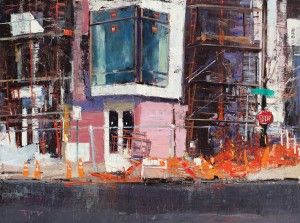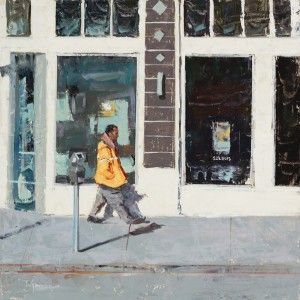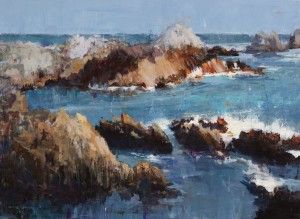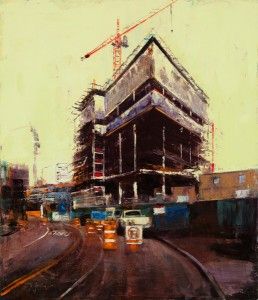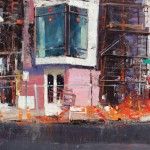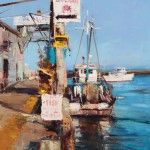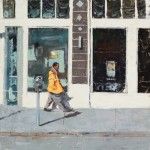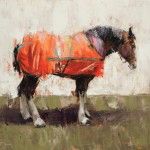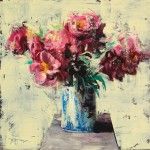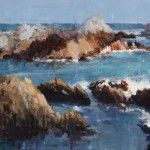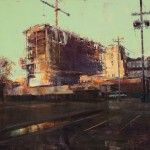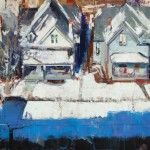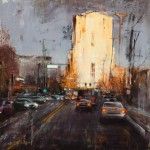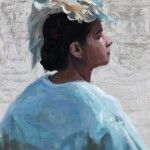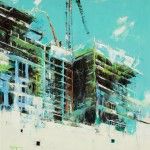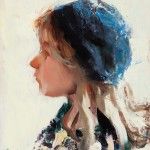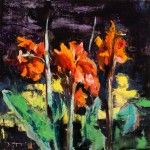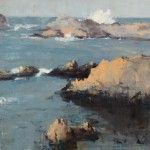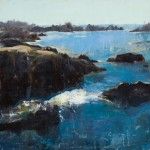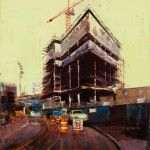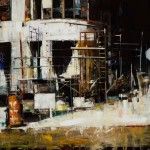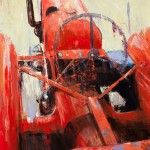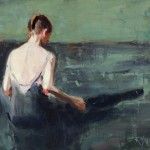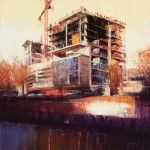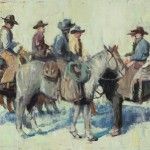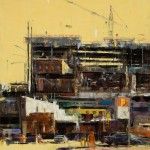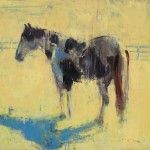Robert Spooner sets a course and then lets serendipity lead the way
By Gussie Fauntleroy
This story was featured in the August 2015 issue of Southwest Art magazine. Get the Southwest Art August 2015 print issue or digital download now–then subscribe to Southwest Art and never miss another story!
The straight-arrow route has never been Robert Spooner’s mode of getting from here to there, in life or in art. Instead, it’s been diversions, meandering side trips, and unplanned pivots that have led to his present life circumstances and approach to art—and he likes it that way. Even trying to describe his painting style and genre takes him on a spontaneous, circuitous ride. “It’s funny to have to put a name on it, to classify it so someone can put it somewhere in their head,” he muses. “If you look at a still life a certain way, for example, it could be a landscape, a miniature landscape on a table. See where my brain goes? It never sits in one place very long.”
Spooner smiles, relaxing in a big yellow chair in his studio, which is located in a warehouse district in downtown Denver. Where the painter has ended up, in life and art, is the New West. It’s a little like the Old West in the sense that every day is an adventure and that opportunity—artistic freedom, in this case—is as inviting and wide open as the Colorado sky. Spooner uses that opportunity to take traditional subjects in a new direction, transforming representational imagery into something harder to classify, with a compelling contemporary edge. In fact, much of what happens in the 59-year-old artist’s studio these days is new to him as well, as his past explorations lead to fresh possibilities while he happily hangs on for the ride.
The Old West may not appear in Spooner’s art, but it figures significantly in his personal history. His grandmother traveled in a horse-drawn wagon from Texas to the-middle-of- nowhere New Mexico, and his mother later settled in Roswell, NM, where Robert was born. He doesn’t recall how his teachers knew he was good at art, but as a schoolboy he was asked to design and paint backdrops for plays. “I think somehow other people realized I had artistic talent before I did,” he says. After his mother married an Air Force serviceman, the family lived in California, then Louisiana. Young Robert attended eight different elementary schools, including three in just one year. As he puts it wryly, “I was never in one place long enough to really capture the concept of math or sentence structure, so I enjoyed art.” He earned a bachelor’s of fine art in advertising design from Louisiana Tech University with a focus on illustration, inspired by his heroes of that discipline’s golden age.
Following graduation, Spooner worked for a time at an ad agency in Shreveport, LA. Then came one of his life’s more interesting detours: four years in Helsinki, Finland. He made the trip at the invitation of a college buddy who was living there, then decided to stay to earn an MBA in economics. (Apparently he figured out sentence structure and math at some point.) He painted a little and showed his work in Finland, but at that time he was still inclined to an illustrative approach.
In 1992, when Finland’s economy was foundering and its unemployment rising, Spooner returned to the United States. He bought a 1963 pickup truck of dubious dependability in Roswell and coaxed it north to Denver, feeding it 13 quarts of oil along the way. In Denver he bought an old computer and taught himself to use design software. He designed colorful tea boxes for Celestial Seasonings and worked as a freelance graphic designer before discovering the Art Students League of Denver. There, as an antidote to the creative constrictions of the advertising world, he studied with acclaimed painters Mark English and, later, Quang Ho. On his own, Spooner carefully studied the works of painters he respected, essentially employing “reverse engineering” to determine how they created the effects he admired.
Another decisive experience took place in Taos, where Spooner encountered early 20th-century paintings by Russian-American artist Nicolai Fechin and members of the Taos Society of Artists. He was overwhelmed with the beauty and complex layering Fechin achieved with dry-brush methods. And so Spooner faced a question that had challenged him since the start of his efforts in fine art: How to incorporate techniques acquired through studying other artists’ paintings while establishing a singular style and look of his own. “How could I create beautiful layers but not paint like Fechin?” he remembers wondering.
The first answer: Put away the brushes and work almost exclusively with a palette knife. Removing the sense of control that brushes provide—using them only for fine details—Spooner found himself free to roam in directions he’d never considered before. “It was a whole new adventure. Along the way I developed the concept I think of as scrape and shape,” he says. “When a painting wasn’t working, I had been taking a drywall tool and scraping down through layers of dry and wet paint, and in doing that the paintings started to reveal something to me—shapes emerging from the layers of what I’d been working on.” Then the question became: “I’m getting things by accident that I absolutely love. How do I create that intentionally?”
The next answer, paradoxically, involved giving up even more control. After removing paint by scraping and sanding, Spooner sets a painting aside for a while. “I’m looking at one now. I’ve pulled some paint off, and there are blended tones and colors, disrupted edges,” he says. “I wait to see what the painting says. I’m watching for visual opportunities to reveal themselves. I’m learning the sensitivity of listening to shapes and layers saying that this is what they want to be.” The process can continue for weeks, with each day’s progress guiding him to the next step. The results are paintings that position themselves along a spectrum between representational and abstracted, although never losing a connection with the subject by straying into pure abstraction.
As part of this ongoing creative exploration, Spooner recently began employing another nonbrush tool, which he playfully refers to as “fairy wings.” That’s code for “I don’t want to tell.” At least, not yet. It’s like discovering an entrancing hidden canyon while on a hike and not wanting to announce its location to the world, he says. “I’m still at that point where I’m a little selfish about it because I’m just discovering it. I don’t want any tag-alongs on the hike.” Using this and other tools, he creates intricately layered paintings with areas of transparency where, as he puts it, “magical things start to happen.”
Much of Spooner’s recent imagery incorporates structures, including industrial or agricultural edifices as well as buildings under construction. Even as details are concealed and reshaped by scraping, reapplying, and moving paint around, the linear elements in these works contribute to strong compositions and a stark, muscular mood. URBAN RENEWAL is part of a series he began after noticing numerous tall construction cranes while driving around Denver. On one such occasion, the painter was struck by the sight of a mammoth building-in-process lit by an intense evening glow after a thunderstorm. In the resulting painting, a sense of the city’s dynamic, ever-changing quality is accentuated by strong patterns of light and dark and the artistic license of an almost unsettling green sky.
Even without the inherent structure of vertical and horizontal lines, Spooner’s practice of subtracting and adding paint produces visual complexity and a vibrant feeling of movement. A good example is the seascape TEMPERATE TIDE. “What’s interesting is that it has no structure. There were only the rocks and the shape of the ocean,” he says. “If I try to paint it directly, it becomes too obvious, too deliberate. So I paint it and then destroy the shapes. I knock it down to let something else happen, to let the painting evolve on its own.”
Lately, with imagery inspired by a recent trip to Europe, Spooner’s art has begun moving into another new phase, one that deftly incorporates both ends of the pendulum swing between realism and what he calls his more ethereal work. Fine details remain in some areas, while others reveal layers and spaces where the viewer is free to fill in visual and metaphoric meaning. “Everything I’ve been doing has led up to this body of work—mixing the controlled and uncontrolled approach to get to something beyond the literal,” he says.
Likewise, his travels through France, Holland, and Belgium (1,800 miles in 10 days) combined conscious decisions and the hand of serendipity, as he chose a general route but then found a place to sleep wherever he ended up stopping for the night. It was all in the service of photos that captured intriguing shapes and imagery—windmills, fishing villages, rivers, farms—in dramatic or beautiful light. “I’m excited about the new subject matter,” Spooner says. “I always learn more from the diversions I take than from all the traditional techniques. I know where I’ve been, but I don’t know what’s in front of me, next week or next year. To me it’s all about taking what I’ve grown through and then asking, Where can I take this? I have many adventures to chase.”
representation
Abend Gallery Fine Art, Denver, CO; Evergreen Fine Art, Evergreen, CO; Principle Gallery, Charleston, SC; RS Hanna Gallery, Fredericksburg, TX; www.spoonerfineart.com.
Featured in the August 2015 issue of Southwest Art magazine–click below to purchase:
Southwest Art August 2015 print issue or digital download Or subscribe to Southwest Art and never miss a story!
- Robert Spooner, Construction Cones, oil, 30 x 40.
- Robert Spooner, Fresh Fish Live Crab, oil, 22 x 18.
- Robert Spooner, Lunch Break, oil, 24 x 24.
- Robert Spooner, Orange Julius, oil, 25 x 30.
- Robert Spooner, Paint Bucket Peonies, oil, 24 x 24.
- Robert Spooner, Temperate Tide, oil, 36 x 49.
- Robert Spooner, Urban Renewal, oil, 31 x 34.
- Robert Spooner, Winter Patterns, oil, 30 x 40.
- Robert Spooner, Beneath the Storm, oil, 30 x 30.
- Robert Spooner, Blue Chiffon, oil, 18 x 16.
- Robert Spooner, Blue Heron, oil, 44 x 48.
- Robert Spooner, Blue Knit Cap, oil, 12 x 10.
- Robert Spooner, Garden Glads, oil, 30 x 30.
- Robert Spooner, Monterey Gray, oil, 36 x 36.
- Robert Spooner, Morning Tide, oil, 48 x 48.
- Robert Spooner, Off Site, oil, 35 x 30.
- Robert Spooner, Portico, oil, 49 x 60.
- Robert Spooner, Red Tractor, oil, 49 x 36.
- Robert Spooner, Rehearsal Warmup, oil, 10 x 14.
- Robert Spooner, Sunset Sentinel, oil, 60 x 60.
- Robert Spooner, Urban Roundup, oil, 30 x 60.
- Robert Spooner, Yellow Jacket, oil, 49 x 40.
- Robert Spooner, Yellow Pinto, oil, 16 x 18.
MORE RESOURCES FOR ART COLLECTORS & ENTHUSIASTS
• Subscribe to Southwest Art magazine
• Learn how to paint & how to draw with downloads, books, videos & more from North Light Shop
• Sign up for your Southwest Art email newsletter & download a FREE ebook






